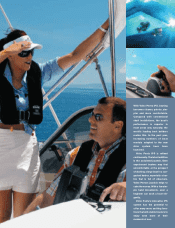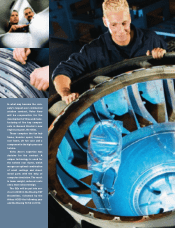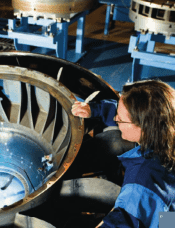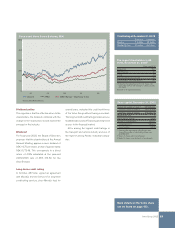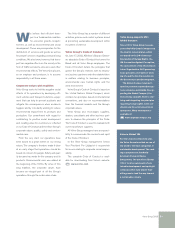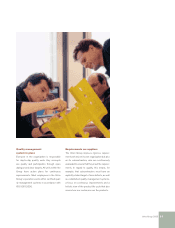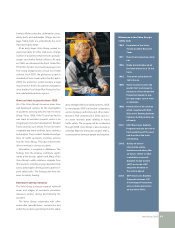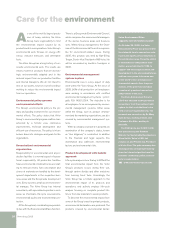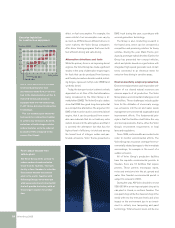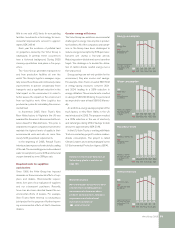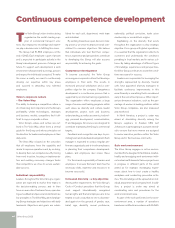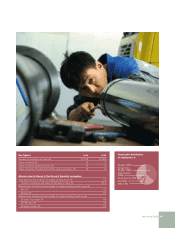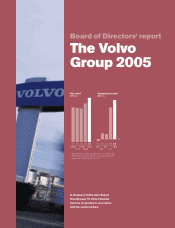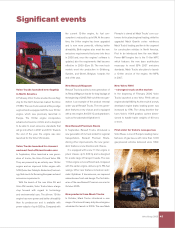Volvo 2005 Annual Report Download - page 39
Download and view the complete annual report
Please find page 39 of the 2005 Volvo annual report below. You can navigate through the pages in the report by either clicking on the pages listed below, or by using the keyword search tool below to find specific information within the annual report.
Volvo Group 2005 35
Milestones in the Volvo Group’s
safety work
1969 Formation of the Volvo
Trucks Accident Research
Team.
1977 Volvo Trucks launches safety
cab.
1986 Brake discs introduced on
the front wheels on a 13-ton
truck.
1992 Two-point safety belts fit-
ted in buses.
1996 Volvo Trucks becomes the
world’s first truckmaker to
introduce a Front Under Run
Protection System to pro-
tect passenger cars in front-
al collisions.
1998 Introduction of disc brakes
which, together with EBS
(Electronic Braking System),
improves braking safety sig-
nificantly.
2001 ESP (Electronic Stability
Program) reduces the risk of
trucks skidding off the road
and the risk of the truck
overturning.
2003 Safety on board –
information, safety
brochures and safety film
on buses, similar to what
is available on aircraft.
Adaptive Cruise Control
(ACC) on trucks. ACC
keeps the distance to
the vehicle ahead.
2004 ESP (Electronic Stability
Program) on buses. FIP
(Front Impact Protection),
extra collision protection
on the Volvo 9700.
frontal collision protection, deformation zones,
safety belts and deformable fittings and air-
bags. Safety belts are undoubtedly the most
important safety detail.
At an early stage, Volvo Group worked on
improving safety for other road-users. A large
number of accidents between trucks and pas-
senger cars involve frontal collisions. As early
as 1996, we introduced the Front Under Run
Protection System to prevent passenger cars
from being wedged under a truck in a frontal
collision. As of 2001, the protection system is
standard on Volvo trucks within the EU, and in
2003, the protection system became a legal
requirement in the EU. Accident investigations
show that the Front Under Run Protection Sys-
tem substantially reduces injuries.
Own accident research since 1969
All of the Volvo Group’s business areas have
well-developed systems for the investigation
of accidents involving vehicles from the Volvo
Group. Since 1969, Volvo Trucks has had its
own team for accident research, which is an
integral part of product development. Renault
Tru cks a lso h as suc h a te am . T hese two te ams
cooperate and share methods, basic statistics
and analysis. They conduct detailed investiga-
tions of traffic accidents involving vehicles
from the Volvo Group. They also interview the
drivers involved in serious incidents.
Information is compiled in databases. The
findings from the analysis contribute signifi-
cantly to the Group’s safety work. Many of the
Volvo Group’s safety solutions originate from
this research, including energy-absorbent cab
zones, deformable steering wheels and three-
point safety belts. The findings also form the
basis for safety training.
Extensive safety research
The Volvo Group conducts research within all
areas and stages of accidents: preventive
measures, before, during, and following the
accident.
The Volvo Group cooperates with other
automotive manufacturers, researchers and
authorities in various joint projects in the safety
area. Intelligent Vehicle Safety Systems, IVSS,
is one example. IVSS is a Swedish cooperative
venture between authorities and other manu-
facturers, that commenced in 2003 and cov-
ers seven research areas relating to future
traffic safety. The program will be conducted
through 2008. Volvo Group is also involved in
a Human Machine Interaction project, that is,
communication between people and machine.


